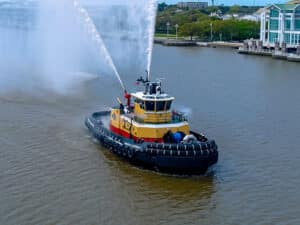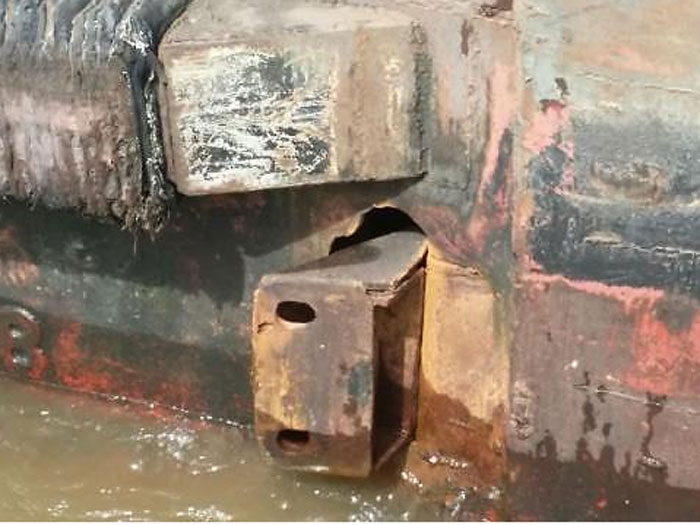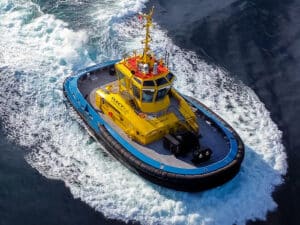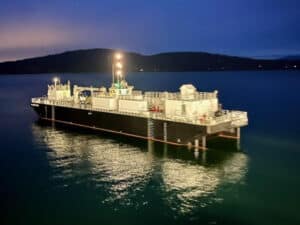
Towboat had hole in hull, so it sank
Written by Nick Blenkey
Cellphone photo, taken by one of the Jim Marko's deckhands, showing the hull breach on the vessel's forward starboard side
JULY 17, 2015 — The take away from this one: if your vessel has a hole in the hull, it’s not such a good idea to just keep going.
The National Transportation Safety Board has issued a report on the July 1, 2015 sinking of the uninspected Osage Marine Services, Inc. towing vessel Jim Marko at mile marker 181.6 on the Upper Mississippi River, near St. Louis, MO.
At the time of the sinking, which occurred at about noon, the1976-built vessel was transiting upriver with a crew of four to a barge fleeting area near Venice, Illinois, immediately northeast across the river from St. Louis. No one was injured in the accident; however, the sinking resulted in damage exceeding the insured value of the vessel, and an undetermined amount of oil was released into the river.
The following extracts from the NTSB report are illuminating.
Crew members told investigators that, about 1030 at the A&D fleeting area, one of the deckhands noticed a hole on the Jim Marko’s starboard side below the rub rail and about 3 feet aft of the turn of the bow. The captain, who was operating the vessel at that time, asked the mate to photograph the hole with his cellphone so that he could see it. The captain looked at the photo, told the mate he would report the hole to the company, and continued operations.
The mate told investigators that he checked the bow void and no water was entering from the hole at that time. The vessel then went to the KMI fleeting area at mile marker 178.5 to top (turn) around a barge. After turning the barge, the Jim Marko (without any barges, or “light boat”) began to travel upriver toward the Venice fleeting area. According to the captain, the vessel developed a slight list to port as it continued toward Venice. About 11.15 AM, while still under way, the deckhand began pumping out the stern void to level the vessel out. After the stern void was pumped, the crew members noticed that the vessel felt like it was down by the bow. About 11.30 AM, they opened the bow hatch to check the bow void and found it quickly filling with water. They attempted to pump the void but were unable to keep up with the flooding. Water was soon coming over the bow and the vessel began listing to starboard.
The crew of a nearby towboat, the Miranda Paige, noticed that the Jim Marko was in distress. The Miranda Paige was about 0.75 miles behind the Jim Marko and pushing a barge upriver. The Miranda Paige captain readied his crew as they approached the rapidly sinking towboat. He had his deck crew members position themselves on their barge with life rings at the ready in case the Jim Marko␣␣ crew had to abandon ship. As they approached, they saw that the Jim Marko had a large starboard heel and the port propeller was visible above the water. The Miranda Paige tow came alongside the vessel’s port bow and the Jim Marko crew was able to abandon the vessel directly onto the barge. The Miranda Paige captain noted that two of the Jim Marko crew members were not wearing shoes and one did not have a life jacket.
Probable Cause
The National Transportation Safety Board determines that the probable cause of the sinking of towing vessel Jim Marko was the captain’s decision to continue operations with a known hull breach in the vicinity of the vessel’s waterline.
Contributing to the rapid sinking was a lack of watertight integrity due to watertight doors on the main deck left open while under way.
Safety Issues noted in the NTSB report:
Abandoning Ship: Crew members should wear appropriate personal protection equipment for their operations under way and should always wear personal flotation devices when abandoning ship. Two crew members on the Jim Marko were barefoot and one did not wear a personal flotation device. The Mississippi River was experiencing high water conditions, which would have posed a heightened risk had crew members been forced to abandon ship into the water.
Watertight Integrity: A hole in the side shell of a vessel, especially a large one near the waterline, poses a serious risk. When a potential hull breach has been identified, operations should be halted until repairs can be made or the crew can determine that the damage does not affect seaworthiness.
Watertight Doors: Water- and weathertight doors should be kept closed when a vessel is under way, unless the crew must pass through them. These doors are critical for preventing ingress of water or stopping its spread if a hull breach and/or flooding occurs.
Download the report HERE





Leave a Reply
You must be logged in to post a comment.